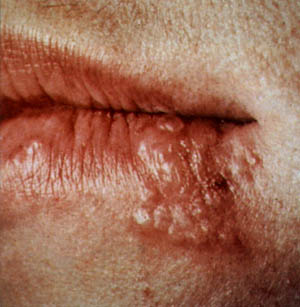A typical reactivation infection cold sore.

Herpes simplex virus 1 (HSV-1) causes primarily herpes labialis which has a recurrent infection characterized by cold sores. Most people are infected at a young age, demonstrated by high seropositivity in young populations. Studeis show that seropositivity to HSV-1 is around 70% in the general population. HSV-1 is transmitted by close personal contact with a person with HSV-1. Even if that person does not have a cold sore, they can still transmit the virus to others. Many people trace their HSV-1 infection to events like being kissed by an older relative as a child.
The primary infection of HSV-1 is often inapparent or unnoticed by the patient. They may experience a mild febrile illness and lesions on or around their mouth after a 2-12 day incubation period. Primary infection can also occur in the eye to cause conjunctivitis and keratitis, the fingers to cause herpetic whitlow (a common problem of dentists) and the genital (potentially through oral-genital contact) region. Complications of primary infection include: herpetic infection of eczematous skin areas leading to severe disease in young children, acute necrotizing encephalitis, and neonatal infection acquired from the genital tract of the mother.
These primary lesions clear up in two to three weeks and the virus is transported to the dorsal root (trigeminal) ganglion, where are able to remain latent. The latent virus stays there for life and can cause recurrent infections characterized by cold sores. Reactivation begins with a prodrome of pain, burining, or itching where a lesion may appear. The lesions generally occur around the junctions of the nose and the skin or the mouth and skin. In about a week, these lesions scab over and the virus returns to latency. The recurrent infections are triggered by a number of factors including: other viral infections, direct sunlight, stress, menstruation, and immunocompromise. In addition, in immunocompromised hosts, reactivation is more severe and has more potentially harmful complications.
A typical reactivation infection cold sore.

Acyclovir is an antiviral drug used to treat HSV-1. It can be used topically or orally to treat primary or recurrent infections. The treatment of HSV-1 with acyclovir can be accomplished with low doses twice daily for up to three years. There are other topical treatments for HSV-1 including penciclovir which is described in detail as a drug profile.
Prevention would require not coming in close personal contact with people with infection, although there would be no way to tell who these people are. Reactivation infections can occur less often if all the provoking factors are avoided.
Created: March 1st, 2000
Updated: March 5th, 2000